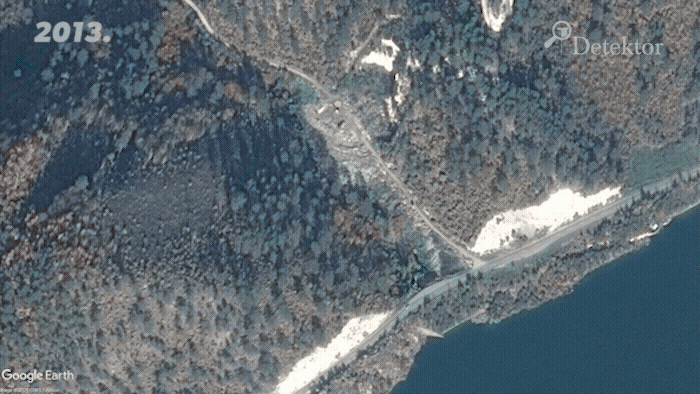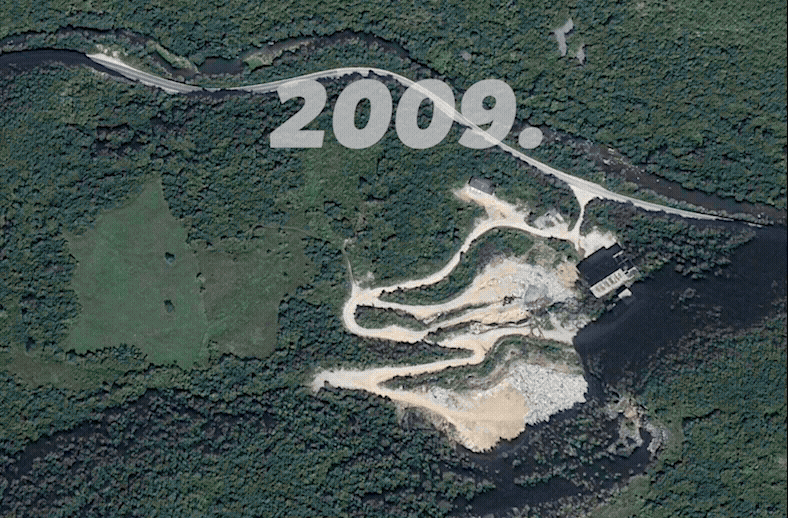This post is also available in: Bosnian
Before it joins the Neretva, the Bregava river in southern Bosnia and Herzegovina slices through the town of Stolac, running beneath three stone bridges that represent just a small part of this area’s rich mix of cultural heritage.
Its waters, however, are not as clean as they once were, thanks to a landfill that was opened near its banks without the necessary permits, in the protected area of the Palaeolithic archaeological site of Badanj Cave.
“The City of Stolac does not have an environmental permit for this landfill, which is why it was not built according to current regulations,” said Berina Amidzic, who lives roughly two kilometres from the dump and heads a local eco association called Concordia.

Landfill in Stolac. Illustration: Detektor/Google Earth
“Waste is dumped in previously dug pits and is occasionally burned, which further worsens the ecological situation,” said Amidzic. “Ecologically, this practice directly pollutes the Bregava River through leachate and uncontrolled burning of waste.”
Satellite images analysed by BIRN show a dramatic expansion of illegal landfills at five sites in Bosnia over the past decade.
According to some estimates, the country hosts more than 1,000 illegal landfills, some of which are encroaching on residential areas or sensitive ecological sites; meanwhile, official municipal dumps frequently lack the required environmental permits issued by the government.

Landfill in Vlasenica. Illustration: Detektor/Google Earth
Muhamed Omerovic, head of the Eco Challenge association in Tuzla and a veteran of environmental activism in Bosnia, estimates the number of illegal landfills in the country at between 1,200 and 1,400.
“We still have inadequate municipal landfills in some places,” he said.
“In some municipalities we have landfills that have not been rehabilitated, and we are asking of each group of municipalities in the cantons of Bosnia and Herzegovina to have a sanitary regional landfill, which are waste processing factories.”
Branka Alempic, who lives near a decades-old illegal landfill in Dragasevac, eastern Bosnia, said politicians were failing to act, while “we live in a reality surrounded by our own garbage”.
Stolac mayor Stjepan Boskovic could not be reached for comment.
Village access road runs through landfill

Landfill in Visegrad. Illustration: Detektor/Google Earth
In Visegrad, eastern Bosnia, the local waste utility company, Komunalac, regularly dumps waste at a landfill that does not have the necessary permit.
Komunalac director Gordana Krivosija said the dump dates to the 1992-95 war in Bosnia. It has been growing ever since.
Residents of the village of Holujaci bear the brunt of the situation, she said.
“The road to the village runs through the landfill,” Krivosija told BIRN, adding that the Visegrad municipality had formed a commission to find a solution.
“In cooperation with the utility company and the municipality, some steps are now being taken to try to remedy the problem of the city landfill to some extent.”

Landfill in Trnovo. Illustration: Detektor/Google Earth
Visegrad mayor Mladen Djurdjevic did not respond to a request for comment.
Local authorities say there is no quick fix to the problem of waste disposal in Bosnia.
In Kiseljak, for example, where municipal authorities use the illegal Berberusa landfill, mayor Mladen Misuric Ramljak said there is a plan to close the site in two to four years and open a regional landfill at the level of the Central Bosnia canton.

“Now the problem is the terrain; no one wants it,” he said. “Landfills must be waterproof, so that there is no seepage. This is not a project of ‘let’s find a hole and dump the garbage in it’. No, it needs to be prepared in every way.”
Despite images showing that the illegal site has expanded over the past decade, Misuric Ramljak denied it had grown.
